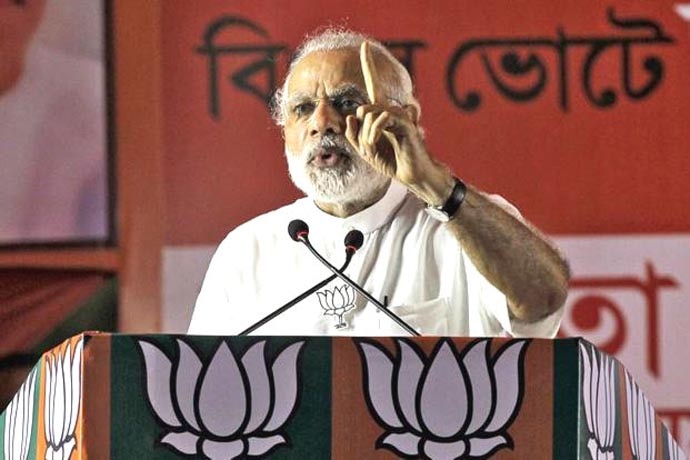Why Delhi media failed to see Modi winning UP elections

It was a historical win for Bharatiya Janata Party (BJP) in Uttar Pradesh as it crossed the 300-mark in the Assembly polls.
Needless to say, Modi has gone on to become a larger-than-life enigma.
The last time a party breached the 300 mark was in 1980, with the Congress winning an unprecedented 309 in that election year — a record the BJP is yet to break.
The BJP has drawn an insurmountable threshold — and Modi remains the biggest factor for the achievement.
The image of a leader who is a hardworking prime minister, who has sacrificed all for the country, one who has never taken a break and worked at the grass roots, triumphed this election.
NaMo despite DeMo
Far from damaging his party's poll prospects, demonetisation helped Modi in Uttar Pradesh as it helped Modi build up on the Robinhood image and woo the ordinary citizen.
Other policies like Ujjwala yojna forced women candidates to come together and support the saffron wave.
 |
| Vote polarisation worked for the BJP. |
BJP reopened its account in Muslim stronghold Deoband after 15 years.
A minority bastion, Deoband is also notorious as "fatwa city", and getting this seat is significant for the BJP as candidates from the minority community have retained the seat for three terms.
The vote division between two Muslim candidates in Deoband helped the BJP win the seat. The party's stand on triple talaq may have turned some Muslim women in its favour.
UP ko ye saath nahi pasand hai
The two good boys of Samajwadi Party and the Congress, Akhilesh and Rahul couldn't do any wonder. In fact, they are struggling for the 70-mark.
This is their grand defeat as voters do gather, but their votes couldn't. The "do achhe ladke" remark couldn't make a mark.Akhilesh Yadav bore the brunt of the Yadav family feud. This was anticipated, but not as it has played out. SP patriarch Mulayam Yadav had earlier made it clear that the alliance will do no good for the party.
Akhilesh's development image failed when it came to the alliance —and it seems Netaji was right in predicting the drubbing.
For Rahul Gandhi, it was a litmus test he didn't pass. He talked to the Uttar Pradesh voters, sharpened his oratory skills, all in vain.
The Congress, however, had guessed its performance, which prompted it to turn to an alliance.
Behenji faces rout; blames it on polarisation
Mayawati was the shell shocked candidate this election season, its hopes tarnished.
With three seats in west UP and three in east UP — and a mere 13 in Bundelkhand, the BSP has been reduced to a sorry figure in UP. Behenji certainly needs time to absorb this.
Her shock at Muslims having voted for BJP is certainly worth pondering.
General Election 2014 too witnessed Muslims voting for Modi, with only 22 per cent voting for the BSP — this is the second defeat for Mayawati's party.
Vote polarisation worked for the BJP. Amit Shah and Modi went about appeasing Hindus by calling for shutting down slaughter houses, accusing the incumbent government of discriminating among communities with its laptop distribution schemes — and introducing acronyms like "KASAB".
The Hindu-Muslim divide remained apparent in the seven phases, especially in western and eastern Uttar Pradesh. BJP has won 102 seats in the former and an overwhelming 119 seats in the latter.
Modi now, Modi in 2024
It's Modi again in Year 2019: if these elections are any indication, it will be easy to predict Modi's win in the 2019 general election.
Jammu and Kashmir National Conference leader Omar Abdullah talks straight, and perhaps, is right when he says, forget 2019, prepare for 2024. It proves the opposition too is no longer ruling out a second massive Lok Sabha sweep.
The Gujarat elections in December 2017 will be a talking point in the coming time. For now, Mission 2017 has worked well for Narendra Modi.

